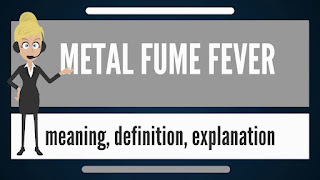Metal fume fever, also known as brass founders' ague, brass shakes, zinc shakes, galvie flu, metal dust fever, Welding Shivers, or Monday morning fever, is an illness primarily caused by exposure to chemicals such as zinc oxide (ZnO), aluminum oxide (Al2O3), or magnesium oxide (MgO) which are produced as byproducts in the fumes that result when certain metals are heated. Other common sources are fuming silver, gold, platinum, chromium (from stainless steel), nickel, arsenic, manganese, beryllium, cadmium, cobalt, lead, selenium, and zinc.
Welders are commonly exposed to the substances that cause metal fume fever from the base metal, plating, or filler. Brazing and soldering can also cause metal poisoning due to exposure to lead, zinc, copper, or cadmium. In extreme cases, cadmium (present in some older silver solder alloys) can cause loss of consciousness.
Video Metal fume fever
Signs and symptoms
The signs and symptoms are generally flu-like. They include fever, chills, nausea, headache, fatigue, muscle aches, joint pains, lack of appetite, shortness of breath, pneumonia, chest pain, change in blood pressure, and coughing. A sweet or metallic taste in the mouth may also be reported, along with a dry or irritated throat which may lead to hoarseness. Symptoms of a more severe metal toxicity may also include a burning sensation in the body, shock, no urine output, collapse, convulsions, shortness of breath, yellow eyes or yellow skin, rash, vomiting, watery or bloody diarrhea or low or high blood pressure, which require prompt medical attention. Flu-like symptoms normally disappear within 24 to 48 hours. Full recovery often requires one to three weeks.
Maps Metal fume fever
Cause
Metal fume fever is due to the inhalation of certain metals, either as fine dust or most commonly as fumes. Simple metal compounds such as oxides are equally capable of causing it. The effects of particularly toxic compounds, such as nickel carbonyl, are not considered merely metal fume fever.
Exposure usually arises through hot metalworking processes, such as smelting and casting of zinc alloys, welding of galvanized metals, brazing, or soldering. If the metal concerned is particularly high-risk, the residue from cold sanding processes may also cause fume fever, even if the dose is lower. It may also be caused by electroplated surfaces or metal-rich anti-corrosion paint, such as cadmium passivated steel or zinc chromate primer on aluminium aircraft parts. Exposure has also been reported in use of lead-free ammunition, by the harder steel core stripping metal from the jacket of the bullet and barrel of the rifle.
The most plausible metabolic source of the symptoms is a dose-dependent release of certain cytokines, an event which occurs by inhaling metal oxide fumes that injure the lung cells. This is not an allergic reaction, though allergic reactions to metal fumes can occur.
Diagnosis
Diagnosis is primarily anecdotal, that is, it depends upon a good occupational history. Diagnosis of metal fume fever can be easily missed because the complaints are non-specific, resemble a number of other common illnesses, and presentation occurs typically 2-4 hours after the exposure. When respiratory symptoms are prominent, metal fume fever may be confused with acute bronchitis or pneumonia. The diagnosis is based primarily upon a history of exposure to metal oxide fumes. Cain and Fletcher (2010) report a case of metal fume fever that was diagnosed only by taking a full occupational history and by close collaboration between primary and secondary health care personnel.
Physical symptoms vary among persons exposed, depending largely upon the stage in the course of the syndrome during which examination occurs. Patients may present with wheezing or crackles in the lungs. They typically have an increased white blood cell count, and urine, blood plasma and skin zinc levels may (unsurprisingly) be elevated. Chest X-ray abnormalities may also be present.
An interesting feature of metal fume fever involves rapid adaptation to the development of the syndrome following repeated metal oxide exposure. Workers with a history of recurrent metal fume fever often develop a tolerance to the fumes. This tolerance, however, is transient, and only persists through the work week. After a weekend hiatus, the tolerance has usually disappeared. This phenomenon of tolerance is what led to the name "Monday Fever".
In 2006, approximately 700 metal fume exposures were reported to the United States Poison control center. The American Welding Society estimated that 2500 employees in the steel industry develop metal fume fever in the US each year and that the majority of the cases are not reported.
Treatment
Treatment of mild metal fume fever consists of bedrest, keeping the patient well hydrated, and symptomatic therapy (e.g. aspirin for headaches) as indicated. In the case of non-allergic acute lung injury, standard or recommended approaches to treatment have not been defined.
The consumption of large quantities of cow's milk, either before or immediately after exposure is a traditional remedy. However, the United Kingdom Health and Safety Executive challenges this advice, warning, "Don't believe the stories about drinking milk before welding. It does not prevent you getting metal fume fever."
Prevention
Prevention of metal fume fever in workers who are at risk (such as welders) involves avoidance of direct contact with potentially toxic fumes, improved engineering controls (exhaust ventilation systems), personal protective equipment (respirators), and education of workers regarding the features of the syndrome itself and proactive measures to prevent its development.
In some cases, the product's design may be changed so as to eliminate the use of risky metals. NiCd rechargeable batteries are being replaced by NiMH. These contain other toxic metals, such as chromium, vanadium and cerium. Cadmium is often replaced by other metals. Zinc or nickel plating can be used instead of cadmium plating, and brazing filler alloys now rarely contain cadmium.
See also
- Occupational asthma
- Polymer fume fever
References
External links
- Inhalation fever
- https://web.archive.org/web/20081006052626/http://files.aws.org/technical/facts/FACT-25.PDF
- Kelleher, P; Pacheco, K; Newman, L. S (2000). "Inorganic dust pneumonias: The metal-related parenchymal disorders". Environmental Health Perspectives. 108 Suppl 4: 685-96. doi:10.2307/3454405. PMC 1637664 . PMID 10931787.
Source of the article : Wikipedia

